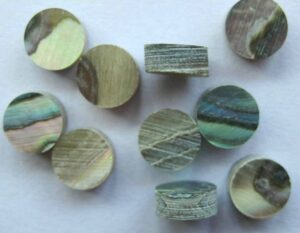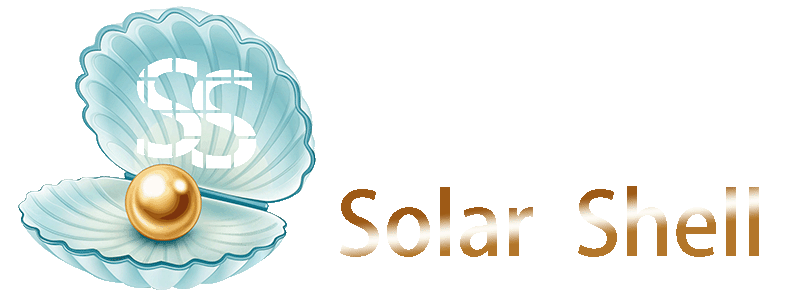What are mother of pearl shell dots and how are they used?
Curious about those shiny dots on guitars? Unsure of their origin or purpose? Discover the beauty and function of mother of pearl shell dots today.
Mother of pearl shell dots are small, circular inlays made from natural shell. They are primarily used as decorative and functional position markers on musical instrument fretboards, but also in other crafts.

THICK ABALONE SHELL DOTS
Mother of pearl dots, often seen shimmering on the fretboards of guitars and other stringed instruments, are more than just pretty embellishments. These small pieces of natural shell combine aesthetic appeal with practical functionality. But what exactly are they, how are they made, and what determines their characteristics and diverse applications? Let’s delve into the world of these iridescent little wonders.
What are mother of pearl dots?
Seen shiny dots on instruments but unsure what they are? Their subtle gleam might hide their true nature. Define these elegant, functional shell components now.
Mother of pearl dots are precisely crafted circular inlays made from the nacreous inner layer of various shells, primarily used for decoration and as position markers on instruments.

paua shell dots
Mother of pearl dots, as your insight Shell fret markers refer to fret markers made from shell materials clearly states, are small, typically circular pieces crafted from selected natural shell materials. The primary allure of these dots is the captivating, iridescent play of light inherent in mother of pearl (nacre), which lends an elegant visual appeal to any item they adorn.
Key Raw Materials:
The beauty and characteristics of the dots depend heavily on the shell source. Your insights specify: The main raw materials for making fret markers are: abalone shells or called paua shells, whitelip shells, yellowlip shell, and Chinese freshwater shells.

abalone shell dots

yellowlip mother of pearl shell dots

whitelip mother of pearl shell dots

chinese freshwater shell dots
| Shell Type | Common Characteristics |
|---|---|
| Abalone (Paua) Shells | Rich, vibrant blues, greens, purples, and blacks. |
| Whitelip Shells | Classic creamy white to silvery iridescence. |
| Yellowlip Shell (Gold Lip) | Warm golden, yellow, and cream tones with strong luster. |
| Chinese Freshwater Shells | Varied, often white, pink, or lavender hues, good value. |
These natural variations mean each dot can be unique, adding to its exclusivity.
How are mother of pearl dots made?
Wonder how intricate MOP dots are formed? The process might seem complex for such small items. Uncover the surprisingly straightforward manufacturing steps involved.
Mother of pearl dots are made by punching blanks from raw shell material using a button-holing machine, then grinding them flat to the desired thickness and smoothness.
The creation of mother of pearl dots is a precise process, as detailed in your insights: Its production method is very simple. You only need to use a conventional shell button punching machine, place the selected shell raw material under it, and punch out the shell button blanks of the required thickness and size. Then, place it on a flat grinding machine to flatten and set the thickness on the top side, and remove the skin from the back of the button blank.
This translates to the following steps:
| Step | Description |
|---|---|
| 1. Material Selection | Chosen raw shell material (Abalone, Whitelip, Yellowlip, Freshwater) is prepared. |
| 2. Punching Blanks | A conventional shell button punching machine punches out shell button blanks. |
| 3. Grinding & Finishing | Blanks are placed on a flat grinding machine to flatten and set thickness and remove backing. |
This streamlined method ensures consistency in size and thickness for various applications.
What are common mother of pearl dot sizes and thicknesses?
Choosing MOP dots but unsure about dimensions? The wrong size can affect look and fit. Understand common dimensions and customization options for perfect application.
Mother of pearl dots are available in standard diameters like 6.3mm, 5.0mm, 4.0mm, and 3.0mm, with typical thicknesses of 2mm, 4mm, and 6mm, though all dimensions can be customized.
![]()
The diameter size of mother of pearl shell dots
Your insights provide specific common dimensions: Conventional shell fret marker sizes are: Diameter: 6.3mm, 5.0mm, 4.0mm, 3.0mm. Thickness: 2mm, 4mm, 6mm. This offers a good starting point for many applications, particularly in luthiery for fretboard face dots and side markers.
| Dimension | Common Sizes Provided |
|---|---|
| Diameter | 6.3mm, 5.0mm, 4.0mm, 3.0mm |
| Thickness | 2mm, 4mm, 6mm |
Crucially, you note: "Note: all the diameter and thickness can to be changed as required." This flexibility is vital, as different instruments or decorative projects may have unique requirements. For instance, smaller diameters (e.g., 1.5mm – 2.5mm) are often used for side fret markers, while larger custom shapes might be used for elaborate headstock inlays or furniture accents. The thickness needs to be sufficient for durability and inlay depth but not overly cumbersome. The manufacturing process allows for this tailoring.
What are the uses of mother of pearl dots?
Got MOP dots but not sure of all applications? Their beauty suggests diverse uses beyond just guitars. Explore the wide range of their decorative and functional roles.
Mother of pearl dots are widely used as fretboard markers on musical instruments, headstock logos, furniture inlays, jewelry, and other decorative craft applications enhancing aesthetics and function.

All kinds of shell dots
Mother of pearl dots serve a multitude of purposes, as highlighted by your insights: Shell fret markers are commonly used in various musical instruments and decorative items. Their application spans both functionality and pure aesthetic enhancement. Specifically, shell fret markers can be applied to various musical instruments and furniture through different processing methods, such as carving or inlaying/pasting, to increase aesthetics and functionality.
Examples of usage include:
- Musical Instruments:
- Fretboard Markers: using shell fret markers on a guitar fingerboard can enhance the decorative effect. They also provide crucial visual fret positioning for musicians. Your insight and produce a unique timbre/sound when playing,suggests a perceived influence on the instrument’s character, though this is more related to the overall instrument construction, the dots primarily add to visual and tactile experience.
- Logos and Branding: can also be used to make headstock logos, shell adhesive labels, etc.
- Furniture and Decorative Arts: Their use is widely used in the decoration and production of various musical instruments and furniture, including jewelry boxes, knife handles, and custom art pieces.
Conclusion
MOP dots, from various shells, are made by punching and grinding. Common and custom sizes make them ideal for instrument fret markers, logos, and decorative inlays.







